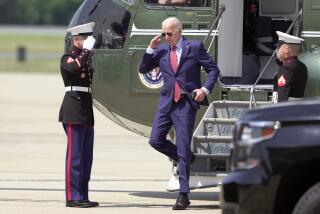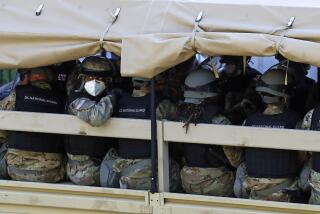Defense Review Unlikely to Seek Overhaul : Military: Policy is set to be made public today. Despite Clinton campaign stand, it is expected to urge modest change in Pentagon strategy and spending.
WASHINGTON — President Clinton has given final approval to a major review of U.S. defense policy, but officials say it is likely to recommend only modest changes in current military programs, despite Clinton’s campaign calls for a major overhaul of Pentagon strategy.
The long-awaited report, undertaken by Defense Secretary Les Aspin and known as the “bottom-up review,” is intended to set forth the Administration’s overall defense strategy and long-range military spending plans for the post-Cold War world.
But indications are that, despite five months in the making, the plan--scheduled to be made public today--will be remarkably similar to the policy and force structure enunciated by the George Bush Administration, which Clinton criticized during the campaign.
Indeed, U.S. officials projected that the changes the Pentagon is proposing actually will require the Administration to spend about $2.8 billion a year, or $14 billion over five years, above Clinton’s current military spending plan--a modest but significant increase.
Military experts said that the recommendations reflect a growing feeling within the Administration that the United States must maintain a strong U.S. military presence abroad--a development that stems from its frustrating experiences with Bosnia, Somalia and North Korea.
Earlier this year, top Aspin aides had been touting the effort as a dramatic departure from previous Pentagon budgetary and policy-making exercises that was likely to result in a major shift in defense policy. More recently, however, they have softened that rhetoric.
As described by officials, the review will recommend permitting the Navy to maintain 12 aircraft carriers, rather than cutting back to 10, as some critics have suggested, and would keep at least 100,000 troops in Europe--both steps to maintain U.S. “forward presence” abroad.
It also would reshuffle plans for building new tactical aircraft. The Air Force would build a new F-22 Stealth fighter but would have to scrap plans to develop its new AFX fighter. The Navy would build a new F-18E/F fighter but would share development with the Air Force.
The Navy also would be allowed to upgrade its existing F-14 aircraft but would have to speed up the retirement of its aging A-6 attack planes. Only 11 of the 12 carriers allotted to the Navy would be deployed on regular runs. The 12th would be used for training aviators.
In addition, the document is expected to recommend reducing the number of Air Force fighter wings to 20 instead of the current 24; the Army’s active duty divisions would be cut to 10 from 14 and the number of Navy ships would be reduced to 340 from a target of 450 before.
The only service to come out ahead would be the Marine Corps, which would maintain its current level of 174,000 Marines--about 15,000 more than recommended by the previous Administration’s “base force” military plan.
The Aspin plan will be touted as designed to enable the United States to fight two major regional conflicts--a Persian Gulf-type war and an attack by North Korea for instance--”almost” simultaneously, much as the previous Administration would have sought.
Kathleen deLaski, the Pentagon’s spokeswoman, said that the plan will attempt “to achieve the right size and right-shaped force for what is really a very different world” following the Cold War. She called it “the first opportunity to clean the slate of the Cold War thinking.”
Clinton, who had been kept apprised of the review as it was developing, approved the document after a meeting Monday with the Joint Chiefs of Staff. “I’m told by his (the President’s) people that he called it a brilliant product,” she said.
But many analysts have been skeptical that the plan will provide either a large enough force or enough money to carry out its proclaimed goal. Moreover, the review is believed to have been narrower in scope than originally touted, for several reasons.
Partly to meet congressional and budgetary deadlines, the Aspin team reportedly did not fully re-evaluate strategic forces--such as bombers, submarines and missiles--but instead stuck only to conventional forces, promising to take up strategic questions in coming months.
And the Administration is not expected to propose any major changes in the basic roles and missions of the individual armed services. Officials said that the report probably will contain some modest proposals in this area, similar to those made last spring by the Joint Chiefs of Staff.
More to Read
Sign up for Essential California
The most important California stories and recommendations in your inbox every morning.
You may occasionally receive promotional content from the Los Angeles Times.










